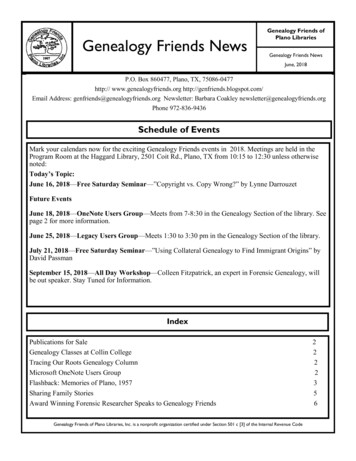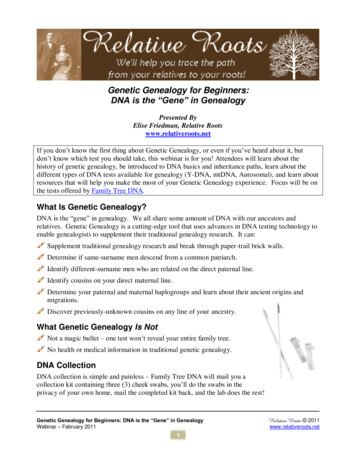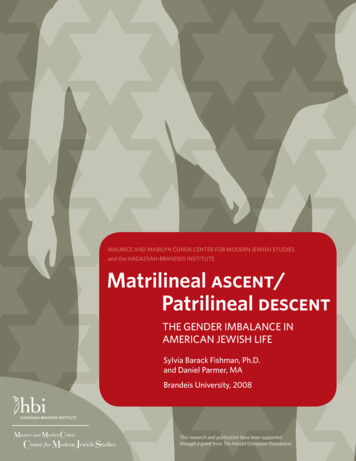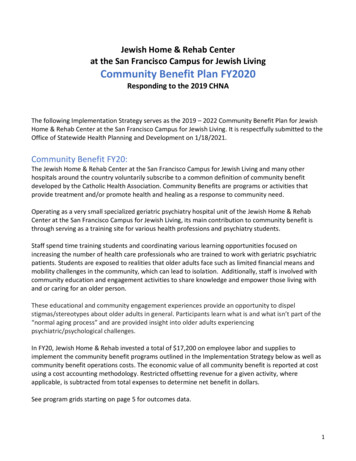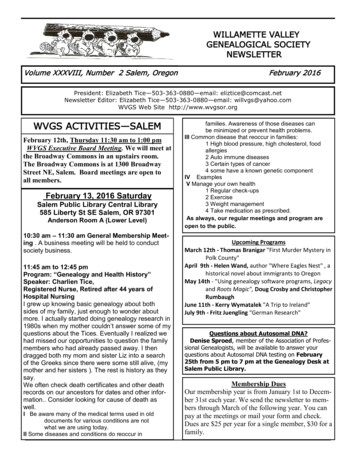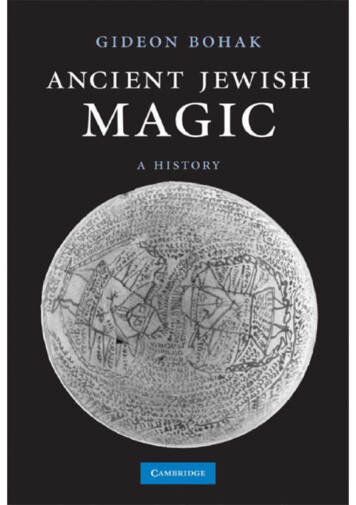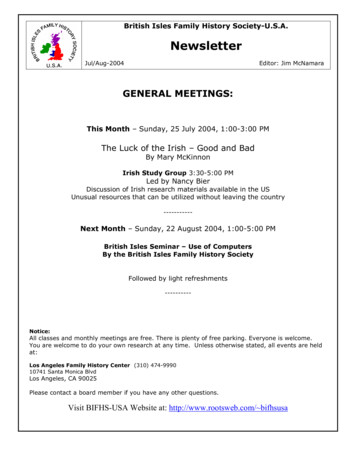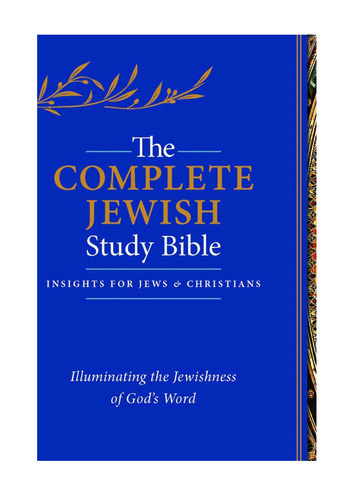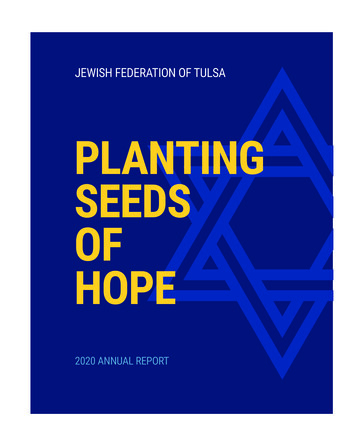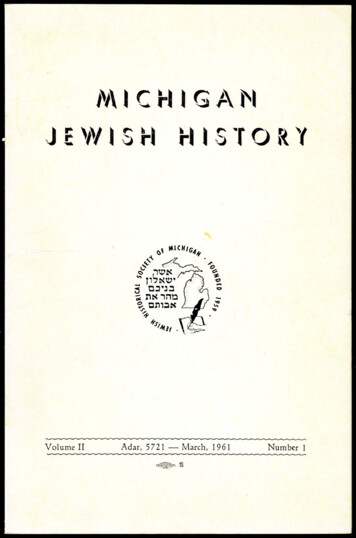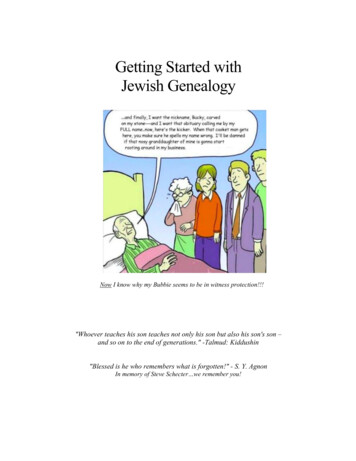
Transcription
Getting Started withJewish GenealogyNow I know why my Bubbie seems to be in witness protection!!!"Whoever teaches his son teaches not only his son but also his son's son –and so on to the end of generations." -Talmud: Kiddushin"Blessed is he who remembers what is forgotten!" - S. Y. AgnonIn memory of Steve Schecter we remember you!
Jewish Genealogical and Archival Society of Greater PhiladelphiaTABLE OF CONTENTSIntroduction . 5Nu, So Let’s Get Started ? .5Getting Organized . 6Forms .6Gathering and Recording Information .6Files or Notebooks? .6Organizing Records .6Genealogy Software .6Tools To Get You Going . . 7Talk to Your Relatives! .7Frequently Asked Questions, Brick Walls, and Bubbe Maysehs .8Spelling Variations - so what was our name, really, and how did they spell it? .8How do I find my ancestral town? .8Using Online Databases to Find Records .9Understanding Primary vs. Secondary Sources . 10Using the Search Box . 10Visiting Archives . 11Types of Records in Genealogical Research .11Birth, Marriage, and Death Records (BMD) . 11Cemetery Records/Tombstones. 11Census Records . 13City Directories . 13Death Certificates . 13DNA Testing . 13Facebook Groups . 14Family Trees . 14Holocaust . 14Landsmanshaft . 15Legal Records . 15Marriage Records . 15Military Records . 15Naturalization Records . 16Copyright by Jewish Genealogical and Archival Society of Greater Philadelphia Compiled by Linda Ewall Krocker - February 20212
Jewish Genealogical and Archival Society of Greater PhiladelphiaNewspapers & Periodicals . 16Obits/Death Notices . 16Passenger Lists . 17Photographs . 17Property Deeds . 17Ships . 17Social Security Death Index . 18Unions . 18Voting Records . 18Written Materials .18Forms . 19Website Links .19Links for Pennsylvania records . 19Jewish Cemeteries and Funeral Homes in the Philadelphia Area .20Resources .21Ackman & Ziff Family Genealogy Institute (AJHS) . 21American Jewish Archives . 21American Jewish Historical Society (AJHS) . 21American Sephardi Federation . 21Annenberg Research Institute . 22Arolsen Archives. 22Avotaynu. 22Balch Database . 22Castle Garden . 22Center for Jewish History (CJH) . 23Deciphering Jewish Tombstones . 23Division of Vital Records . 23Ellis Island . 23Family History Center and FamilySearch Affiliate Libraries . 23Free Library of Philadelphia . 24Genealogical Society of Pennsylvania (GSP) . 24Historic Society of Pennsylvania (HSP) . 24Holocaust Records . 25Copyright by Jewish Genealogical and Archival Society of Greater Philadelphia Compiled by Linda Ewall Krocker - February 20213
Jewish Genealogical and Archival Society of Greater PhiladelphiaImmigrant Bank Records . 25International American Jewish Genealogical Society (IAJGS). 25International Tracing Service (ITS) . 26Jewish Exponent . 26JewishGen.org . 26JOWBR Burial Registry . 26JRI-Poland . 26Libraries . 27Museum of Jewish Heritage, A Living Memorial to the Holocaust . 27National Archives and Records Administration (NARA) . 27Naturalizations . 28National Museum of American Jewish History . 28Newspaper and Database Center. 28Philadelphia City Archives . 28Philadelphia County Records at City Hall (Local Courthouse) . 29Pennsylvania Department of Vital Records . 29The Philadelphia Jewish Archives Collection . 29Pier 53 Immigration . 29Routes to Roots Foundation . 30SteveMorse.org . 30Synagogues . 30United States Holocaust Memorial Museum (USHMM) . 30Webinars . 30World Zionist Organization, Central Zionist Archives . 30Yad Vashem . 31Yiskor (Memorial) Books Project. 31Copyright by Jewish Genealogical and Archival Society of Greater Philadelphia Compiled by Linda Ewall Krocker - February 20214
Jewish Genealogical and Archival Society of Greater PhiladelphiaIntroductionWhy is Jewish genealogy different from other genealogy? There are a lot of other beginner’s guides outthere for people who want to trace their lineage, and eventually you really should read some of them. Thisguide aims to focus a bit more on Jewish genealogy and Philadelphia. Everyone faces the typicalchallenges that dates seem arbitrary and “my family didn’t spell their name that way,” but we learn to gowith the flow. But it can be more challenging tracing our Jewish ancestors. You may discover that yourgreat-grandfather (GGF) had a Hebrew name, a Yiddish name, a Russian name, and an Americanizedname! The old records we seek are usually in a language you can’t speak or read. Records from EasternEuropean countries are not made freely available (yet), and you can’t just go visit the archive in a foreigncountry and find Aunt Sadie’s records in English. To add insult to injury, countries changed names asborders changed! You may not know where to find a Philadelphia cemetery that was bought out byanother cemetery decades ago. You may get tangled up in DNA when you realize that your great-auntmarried her cousin. To quote Avotaynu:Two major events shaped Jewish life of the past two hundred years: migration and the Holocaust. Few Jewstoday live where their ancestors lived a century or two ago. As a result, many Jews believe they cannot tracetheir family roots because:§§§§§My family name was changed (at Ellis Island)No one in my family knows about the pastNo one is left alive to tell me about my family's pastAll the records were destroyed in the HolocaustMy town was wiped off the face of the mapThese statements are myths. Jewish genealogy today is highly organized and therefore help is available to dispelthese myths. There are many resources available to help you trace your Jewish family heritage.§§§§Databases exist on the Internet to get you startedThere are more than 80 genealogical societies throughout the world where you can meet other peopletracing their rootsThere are books on Jewish genealogy; Avotaynu is the leading supplier of these booksThere is a strong presence of Jewish genealogy on the InternetWelcome to Jewish genealogy! So where do we start? Our goals are:§ To begin finding your ancestors§ To accurately document your findings§ To better understand the context of their lives§ To begin identifying the cultural issues that shape us today§ To present specific resources for Jewish research and PhiladelphiaNu, So Let’s Get Started ?Just think about the heritage you’re leaving your children!§ Overcome inertia, begin NOW!§ Success fuels effort§ The journey has value§ Remember the context of Jewish peoples’ lives§ Ask questions, meet members, and seek help at JGASGP meetings§ Enroll family members to help§ Write and deploy results to your familyCopyright by Jewish Genealogical and Archival Society of Greater Philadelphia Compiled by Linda Ewall Krocker - February 20215
Jewish Genealogical and Archival Society of Greater PhiladelphiaGetting OrganizedFormsForms are freely available from Ancestry, Cyndi’s List, Family Tree Magazine, and FamilySearch (theLDS Church). Start with the links at the end of this handbook for several forms and some invaluablehandouts for getting started! The Five-Generation Ancestor Chart is a good place to start, along with thePedigree Chart, Family Group Record, and Research Log-Checklist to track what you find (and don’tfind!).Gathering and Recording InformationWhat do you know about your mishpokhe so far? Begin yourresearch by writing down the names of your ancestors on aPedigree/Ancestral Chart. Start with yourself and yourimmediate family and work outwards from there. Fill in thedates and locations of Birth, Marriage, and Death (BMD).Use the maiden names of female relatives. Use a “?” if youdon’t know a specific fact. Gather any documents that youhave or can obtain from relatives. Be sure to record thesedocuments on the Records Checklist form.TIP: If you have printed out a form, use a pencil instead of apen. As your research progresses, old information willundoubtedly need to be corrected.Files or Notebooks?Loose-leaf binders or manila folders? There is no right or wrong answer, it’s a matter of personal taste.And you may find that you’ll change your mind over the years or use a combination of techniques, startscrapbooking, or hang framed photos on your wall. But whatever you decide, be sure to use acidfree/lignin-free plastic protectors to prevent deterioration over the years especially for any originals youmay acquire!Organizing RecordsOrganize by surname and break it down by family, geography, or whatever seems most reasonabledepending on your research. You can number each document like in a library, and create an index, or usea checklist to see what you have and what you still need. Your memory is not a sufficient storage device!Record conversations, family lore, newspaper clippings, etc., and mark each with Who? Where? When?What? Why? There will be far too much to remember as time goes on. And remember that names andspellings may change over time. A Yiddish name, written in Hebrew, was transliterated to a closeapproximation of the original in English, so Cohen could become Coen, Cowan, Cohan, Cone, Kon,Kohn, Kaan without consideration to errors or poor handwriting. Be creative when you search.Genealogy SoftwareGenealogy computer software provides the best method to store, search, share,correct, and print reports and charts. It’s far simpler than the dozens of scraps ofpaper you’ll have all over your desk! There are several popular software packageson the market, and they should all be able to create a GEDCOM, which is astandardized format you can use to move from one platform to another if you needto upload a tree or move your data if you ever change your software program.Here are some tree-keeping /online-tree-vs-genealogy-software/For PC: Family Tree Maker, Heredis, Heritage, Legacy, Roots Magic, Family Tree Builder, FamilyHistorianCopyright by Jewish Genealogical and Archival Society of Greater Philadelphia Compiled by Linda Ewall Krocker - February 20216
Jewish Genealogical and Archival Society of Greater PhiladelphiaFor Mac: Family Tree Maker, Heredis, Mac Family Tree, Reunion, Roots Magic, Family Tree BuilderAnd here are some software eprogramshttps://en.wikipedia.org/wiki/Comparison of genealogy softwareIt is possible to create and maintain a tree online only, but if the Internet is flakey, the company goes outof business, or you decide not to continue paying for a subscription service, you may no longer haveaccess to your tree and research. It’s far safer to use your computer, and software programs exist that linkto the online tree. And don’t forget to make regular backups! You can’t afford to lose your valuableresearch!Tools To Get You Going .Talk to Your Relatives!Don’t wait ‘til Pesach or Thanksgiving! It is every genealogist’s lamentthat they should have asked questions when they had the chance, whentheir older relatives were still living. So short of holding a séance, now isthe time to pick up the phone and get to know your extended familymembers on a new level, starting with oldest relatives on all sides first!It’s a sad fact of life that those who can answer your questions are adying resource. Visit if you can, and plan on more than one conversationor visit for follow-up. If you have a recorder and camera (your cellphone!), bringit. Ask aboutnames, dates,towns, remembrances and stories, documentsand photos. Aim for more than just birth,marriage, death information gather stories tobring your family members to life! Plan andorganize and be sure to write everything down!Begin a gentle conversation with What? orHow? and avoiding making them feel likethey’re being interrogated.Encouragement and follow-up questions are critical. Convey that this is a pleasure, not a task, and not tobe intimidated by the amount of questions. Start with what they remember most childhood, parenthood,schools, family holidays/celebrations, the house the family was raised in, everyday life, favorites,military, romance, careers, adult life, entertainment, community, moods, attitudes and philosophies,travel, leisure. It makes sense not to bombard yourself or others with too many questions at once, it’soverwhelming. This is a long process, so it’s never too soon to begin.If you’re lucky enough to start with the immigrant generation, here are some sample questions to get youstarted:- What town did they come from?- When did they immigrate to America?- What was the name that they used in the old country?- How many children did they have? What were their names?- Were they married before they came to America? How did they meet?- Did they have other relatives that came to this county?- Where did they live in the U.S.?- What was the neighborhood like?Copyright by Jewish Genealogical and Archival Society of Greater Philadelphia Compiled by Linda Ewall Krocker - February 20217
Jewish Genealogical and Archival Society of Greater Philadelphia-Did they belong to a synagogue? Were they religious? Did they keep kosher?Where are they buried?Did they belong to a landsmanschaft (a supportive organization of people from the same hometown in“the old country”)?Can you tell me some interesting family stories?What were their occupations and hobbies?What foods did they like to eat? Do you have any family recipes?Can you describe the personality of your family members?Do you know of family members lost in the Holocaust? (If so, get all the information you can!)And very important! Do they have any old records and photos? Take pictures of everything they findfor you, including a nice one of them for the portrait thumbnails in your family tree. Photo orphotocopy documents (promise and don’t forget to return them).Frequently Asked Questions, Brick Walls, and Bubbe Maysehs(Hey, if you don’t like my spelling, check Leo Rosten’s Joys of Yiddish). Our name was changed at EllisIsland. No, it wasn’t. Really.that’s a bubbe mayseh. Name changes frequently occurred at theembarkation point when our ancestors signed up for their cruise. Shipping companies had employees whospoke multiple languages, so they probably didn’t misunderstand what they heard. More likely, yourrelative turned to the person in front of him in line, asked his name, and gave that when they wereasked to sound more American! Whatever went into that ship’s log is what was handed to officialswhen they arrived in Castle Garden, Ellis Island, Philadelphia, Baltimore, Galveston, Canada, orwherever. If they didn’t change their name yet, they likely Americanized it after they got here, and just aslikely didn’t do any legal paperwork to do so (what, leave you a paper trail?!). Or they could havelegalized the new name choice in court during the naturalization process.Spelling Variations - so what was our name, really, and how did they spell it?If you don’t know your ancestor’s name, start with a more recent generation. Records of recent ancestorstypically lead to records of earlier generations. Remember, your ancestor’s name may not be listed thesame way in all records. Sometimes they spell it differently even within the same document just to giveyou shpilkes! Look for variations and Hebrew, Yiddish, country (Russian/Polish/Ukrainian) equivalentsor English transliterations. Zayde Jacob may have traveled as Yankel. When using online family trees, iffootnotes and sources are given, copy them into your research log. These may lead to additionalinformation about your ancestor. And by the way, have I mentioned that spelling doesn’t #NamesWildcards – have you ever used wildcards? No, not deuces. Regardless of whether you’re in Google orAncestry or wherever, if you can’t spell the name, use a “?” to replace a single letter that you’re not sureof, or “*” for one or more letters. Ex: if you can’t figure out if the last name is spelled Rosenzweig orRozencwajg or Rozentzwayg or any number of spelling variations, try replacing unknown letters.“Ro?en*g” will show all of those and more. The “?” will give you results with the needed S or Z, and the“*” will result in all the missing letters between the N and G. And be aware that your relatives probablyused many different given names just to confuse you. For example, a woman named Ester Rivka Cohen islisted as the bride on a marriage record in Poland. In the U.S. she is listed on census records as Rebecca orBecky. On her son’s Philadelphia birth record, she is listed as Ester. Go figure. See JewishGen’sKnowledge Base (below) for information on names.How do I find my ancestral town?I’ll bet now you’re sorry you didn’t ask Bubbie when you had a chance! Look here: and you’ll find theJewishGen FAQ (Frequently Asked Questions) for a wealth of help with finding your ancestraltown https://www.jewishgen.org/InfoFiles/faq.html#Towns and Jewish names, Holocaust research, andCopyright by Jewish Genealogical and Archival Society of Greater Philadelphia Compiled by Linda Ewall Krocker - February 20218
Jewish Genealogical and Archival Society of Greater Philadelphialot of other valuable topics. JewishGen’s Knowledge Base also includes “How to Read a HebrewTombstone,” “Jewish Genealogical Research in Eastern Europe,” “Manifest Markings – A Guide toInterpreting,” and “U.S. Passenger List Annotations.” And remember, Jews moved around and may havelived in shtetls (Jewish suburbs) surrounding the towns you may have been told. And to add insult toinjury, names changed frequently, especially every time Poland was acquired by a new conqueror, likeafter WWII. And just for fun, check this site to see if your family surname is associated with a townname: https://www.mygenealogyaddiction.com/countiesUsing Online Databases to Find Records§§§§§§Explore – the more you look, the luckier you getTry the free sites or promo periods firstSpelling does not matter – try lots of alternatives and use Soundex systems. A Yiddish name,written in the Hebrew alphabet, was transliterated to a close approximation of the original, soCohen could become Coen, Cowan, Cohan, Cone, Kon, Kohn, Kaan without consideration toerrors or poor handwriting. Be creative when you search.Sometimes family lore is only partly truePrimary records resolve discrepanciesEuropean borders frequently changed! And some European places were both cities andstates/counties with changed spelling. Keep in mind that even Philly is both a city and a county.FREESUBSCRIPTIONAncestry.com – 2-week free trial with limited access to their collections. Check a wealth of learningguides, their Facebook page, training videos on YouTube, a comprehensive collection of databases ofgenealogical records. Holocaust records are always free.Paid subscriptions include U.S. Discovery, World Explorer, or All Access to records including basic levelaccess to Newspapers.com and Fold3.com. It also enables you to email other family tree owners to shareinformation.FamilySearch.org (LDS Church) hasFold3.com – military records for the Revolutionaryinnumerable genealogical databases andWar, War of 1812, Mexican American and Earlymillions of records from all over the world,Indian Wars, Civil War, Spanish-American War,family trees, records, catalogs, books, images, aWWI, WWII, Korean War, Vietnam War, Recentresearch wiki, pedigrees, etc. Be aware thatWars, non-military and international recordstrees can be edited by anyone.Familytreemagazine.com - great articles in theirmagazine and online on a large variety ofgenealogy topics.GEDmatch.com – the most comprehensive siteHeritageQuest.org can be found on the Freeto upload your DNA test, regardless of whereLibrary of Philadelphia website, free to cardyou test, to find DNA matches from ALL otherholders. Records for the U.S. (including Citysites, offering you a much larger collection ofDirectories) and Canada.matches.Geni.com - family treesJGSNY.org – website for the Jewish GenealogicalSociety of New York, Burial Society information,etc.GesherGalicia.org – vital records, censusJRI-Poland.org – has Polish Jewish vital recordsrecords, archives for towns in Galicia, a former(BMD), resident lists, etc.province of the Austrian Hungarian Empire.Publishes a periodic journal.JewishGen.org has extensive Je
19008-3423 - (610) 356-8507. See the Wiki page for details for classes and events. Salt Lake City, UT Family History Library, 35 North West Temple Street, Salt Lake City, UT 84150 - (801) 240-6996 Free Library of Philadelphia 1901 Vine Street, Philadelphia PA 19103 - (215) 686-5396 - Free public library branches are throughout Philadelphia area.
